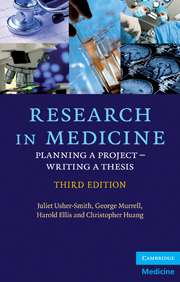Book contents
- Frontmatter
- Contents
- Preface
- 1 Introduction
- 2 Deciding whether to do research
- 3 Deciding when to do research
- 4 Selecting a research degree
- 5 Choosing a department, research supervisor and project
- 6 Applying for research positions and funding
- 7 Getting started
- 8 Overcoming frustration
- 9 Writing scientifically
- 10 Publishing a paper
- 11 Attending scientific meetings
- 12 Writing a thesis
- 13 Submitting a thesis and preparing for the viva voce examination
- Further reading
- Appendix: Information for research students wishing to study overseas
- Index
1 - Introduction
Published online by Cambridge University Press: 05 May 2010
- Frontmatter
- Contents
- Preface
- 1 Introduction
- 2 Deciding whether to do research
- 3 Deciding when to do research
- 4 Selecting a research degree
- 5 Choosing a department, research supervisor and project
- 6 Applying for research positions and funding
- 7 Getting started
- 8 Overcoming frustration
- 9 Writing scientifically
- 10 Publishing a paper
- 11 Attending scientific meetings
- 12 Writing a thesis
- 13 Submitting a thesis and preparing for the viva voce examination
- Further reading
- Appendix: Information for research students wishing to study overseas
- Index
Summary
Aims of this book
This guide was written primarily for medical students and practitioners considering whether to attempt a programme involving original research in the medical and biological sciences. The author who initiated this text (George Murrell) read for a medical degree, did a stint in research and has now returned to clinical medicine (orthopaedic surgery) with an academic interest. He was then joined by two others, one of whom (Christopher Huang) first qualified in medicine and has subsequently remained in research, and another (Harold Ellis) who has had a primarily academic clinical career. In this third edition, they are now joined by Juliet Usher-Smith, who completed a combined MB/PhD programme and is now at the early stages of combining clinical practice with research. Accordingly, the authors themselves represent the major groups and career stages of people who do medical research.
Individuals have different reasons for wishing to do research, which include gaining a higher degree, furthering their medical career or simply taking a break from clinical practice. Such a pursuit can be incredibly exhilarating and rewarding. Alternatively, it can be an endless, lonely, boring and frustrating exercise. The aim of this handbook is to guide the potential medical postgraduate candidate away from the latter predicament. It is not intended to dictate the researcher's own originality, creativity or scientific approach. Rather, it is organized around a sequence of practical steps directed at the more pragmatic questions:
‘What steps do I take?’
‘When and where do I start?’
‘How do I get to the end of the tunnel?’
‘What do I do next?’
We thereby hope to alleviate unnecessary anxiety and save the reader valuable time and energy that could then be used in a more productive way.
- Type
- Chapter
- Information
- Research in MedicinePlanning a Project – Writing a Thesis, pp. 1 - 4Publisher: Cambridge University PressPrint publication year: 2010



